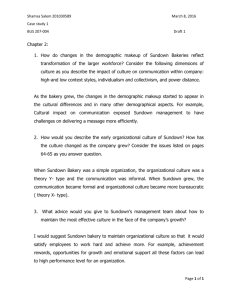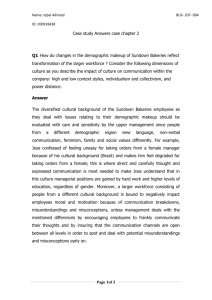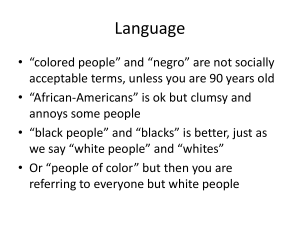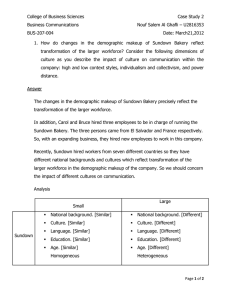Criminalization Fact Sheet - Western Regional Advocacy Project
advertisement
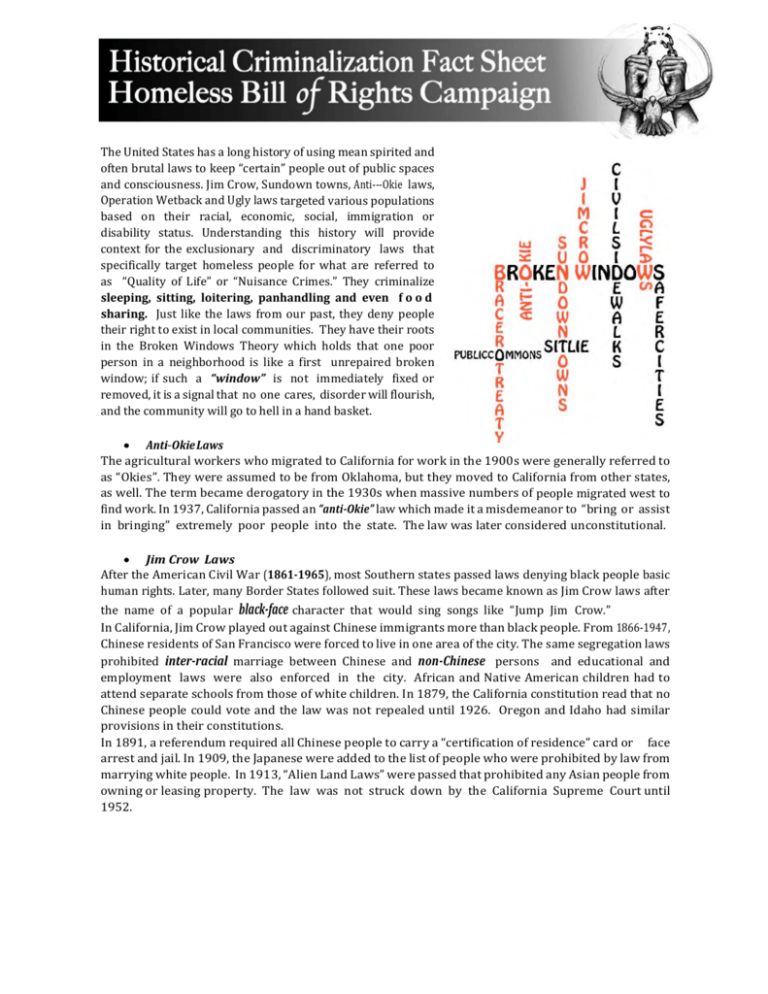
The United States has a long history of using mean spirited and often brutal laws to keep “certain” people out of public spaces and consciousness. Jim Crow, Sundown towns, Anti-­‐Okie laws, Operation Wetback and Ugly laws targeted various populations based on their racial, economic, social, immigration or disability status. Understanding this history will provide context for the exclusionary and discriminatory laws that specifically target homeless people for what are referred to as “Quality of Life” or “Nuisance Crimes.” They criminalize sleeping, sitting, loitering, panhandling and even f o o d sharing. Just like the laws from our past, they deny people their right to exist in local communities. They have their roots in the Broken Windows Theory which holds that one poor person in a neighborhood is like a first unrepaired broken window; if such a “window” is not immediately fixed or removed, it is a signal that no one cares, disorder will flourish, and the community will go to hell in a hand basket. • Anti-­‐Okie Laws The agricultural workers who migrated to California for work in the 1900s were generally referred to as “Okies”. They were assumed to be from Oklahoma, but they moved to California from other states, as well. The term became derogatory in the 1930s when massive numbers of people migrated west to find work. In 1937, California passed an “anti-Okie” law which made it a misdemeanor to “bring or assist in bringing” extremely poor people into the state. The law was later considered unconstitutional. • Jim Crow Laws After the American Civil War (1861-1965), most Southern states passed laws denying black people basic human rights. Later, many Border States followed suit. These laws became known as Jim Crow laws after the name of a popular black-face character that would sing songs like “Jump Jim Crow.” In California, Jim Crow played out against Chinese immigrants more than black people. From 1866-1947, Chinese residents of San Francisco were forced to live in one area of the city. The same segregation laws prohibited inter-racial marriage between Chinese and non-Chinese persons and educational and employment laws were also enforced in the city. African and Native American children had to attend separate schools from those of white children. In 1879, the California constitution read that no Chinese people could vote and the law was not repealed until 1926. Oregon and Idaho had similar provisions in their constitutions. In 1891, a referendum required all Chinese people to carry a “certification of residence” card or face arrest and jail. In 1909, the Japanese were added to the list of people who were prohibited by law from marrying white people. In 1913, “Alien Land Laws” were passed that prohibited any Asian people from owning or leasing property. The law was not struck down by the California Supreme Court until 1952. • Ugly Laws From the 1860s to the 1970s, several American cities had laws that made it illegal for people with “unsightly or disgusting” disabilities to appear in public. Some of these laws were called “unsightly beggar ordinances”. The first ordinance was in San Francisco in 1867, but the most commonly cited law was from Chicago. Chicago Municipal Code section 36034 stated: “No person who is diseased, maimed, mutilated or in any way deformed so as to be an unsightly or disgusting object or improper person to be allowed in or on the public ways or other public places in this city, or shall therein or thereon expose himself to public view, under a penalty of not less than one dollar nor more than fifty dollars for each offense.” • Operation Wetback Operation Wetback began in 1954 in California and Arizona as an effort to remove all illegal, Mexican immigrants from the Southwestern states. The Operation was by the United States Immigration and Naturalization Service (INS) and coordinated 1,075 border control agents along with state and local police agencies. The agents went house to house looking for Mexicans and performed citizenship checks during traffic stops. They would stop any “Mexican looking” person on the street and insist on seeing identification. Operation Wetback was only abandoned after a large outcry from opponents in both the United States and Mexico. • Sundown Towns Sundown Towns did not allow people who were considered "minorities" to remain in the town after the sun set. Some towns posted signs at their borders specifically telling people of color to not let the sun set on them while in the town. There were town policies and real estate covenants in place to support the racism, which was enforced by local police officers. Sundown Towns existed throughout the United States and there were thousands of them before the Civil Rights Act of 1968 prohibited racial discrimination in housing practices. Sundown Towns simply did not want certain ethnic groups to stay in their towns at night. If undesired people were to wander into a Sundown Town after the sun had set, they would be subject to any form of punishment from harassment to lynching. While the state of Illinois had the highest number of Sundown Towns, they were a national phenomenon that mostly targeted anyone of African, Chinese, and Jewish heritage. • Today…… Broken Windows Laws Today’s laws have their roots in the broken-windows theory which holds that one poor person in a neighborhood is like a first unrepaired broken window and if such a “window” is not immediately fixed or removed, it is a signal that no one cares, disorder will flourish and the community will go to hell in a hand basket. A direct outcome of this theory is the introduction of legislation to criminalize the presence of homeless people in public. Current “Quality of Life” laws also take a certain population into account: homeless persons. Using these laws, people are criminalized for simply walking, standing, sleeping, and other regular human behaviors. In other words, they are penalized and harassed simply because of who they are. Just as with Jim Crow, Ugly Laws, Anti-Okie Laws and Operation Wetback, how people look and their very existence is the basis for charging them with criminal behaviors. Western Regional Advocacy Project (415) 621-2533 wrap@wraphome.org www.wraphome.org


